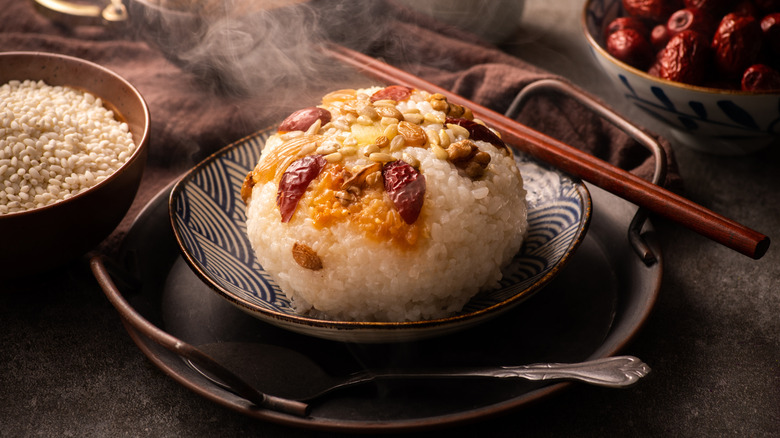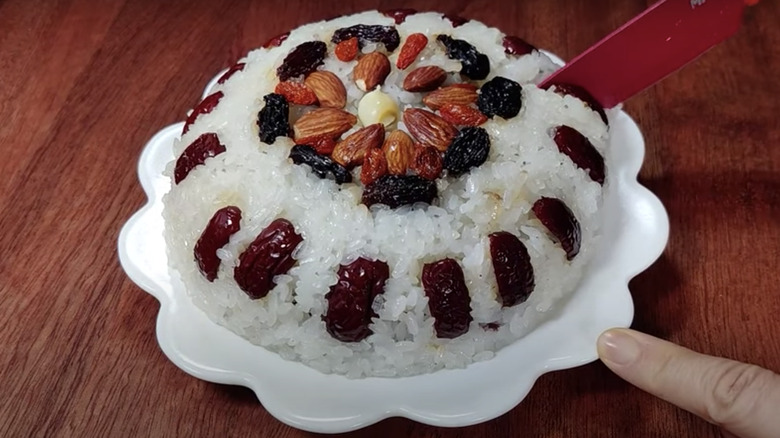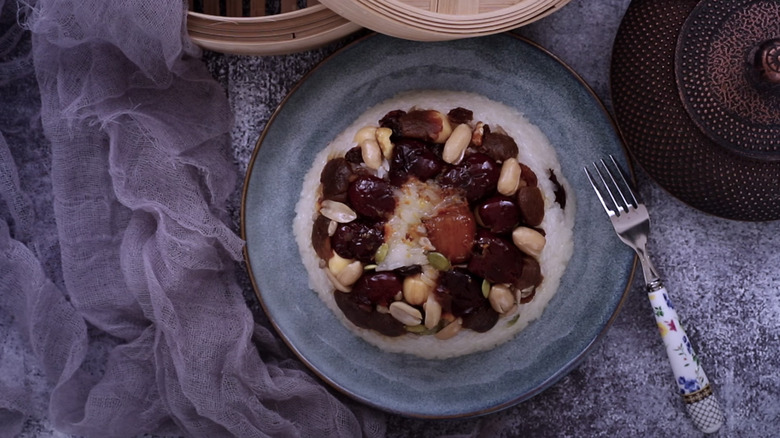The Show-Stopping Rice Dessert That Binds Families On Lunar New Year
Although the majority of us might still be writing down our New Year's resolutions from the more familiar date of January 1, the exact day of the holiday varies by culture. For example, Jews celebrate their New Year, Rosh Hashanah, according to the "Luni-Solar" Jewish calendar. It typically falls in September on the Gregorian calendar (via Almanac).
Muslims use the Islamic calendar to observe Hijri New Year, which falls in July, per National Geographic. And the Lunar New Year is celebrated across China and other parts of Asia, marking the beginning of spring. The kickoff of the holiday starts on the evening before the 15-day celebration — this year falling on January 21, notes China Highlights.
To celebrate, many participate by decorating windows with red paper cutouts and carrying glowing lanterns around in the evening, according to the National Museum of Asian Art. It's also tradition to gather with family and friends and dig into a stunning array of traditional dishes – one of which is the luxe Eight Treasure rice pudding.
The history of Eight Treasure rice pudding
The Eight Treasure rice pudding is made of steamed, sticky rice that hides a center of sweet red bean paste and is crowned with an array of other "treasures," according to The Hong Kong Cookery. These treasures include dried fruits and nuts, such as raisins, apricots, wolfberries, pumpkin seeds, and the Chinese dates known as jujubes. Packed in a mold of layers of sticky rice, red bean paste, and fruits and nuts, the whole dessert is then steamed until soft and fragrant, then inverted onto a plate to show its beautiful pattern of colored ingredients.
According to the Los Angeles Times, legend has it that the dish originated in ancient China as a way to commend the bravery of eight knights who assisted in overthrowing a king. Some attest that the dessert has a shorter history, coming to fame during the Qing Dynasty when a royal cook presented the rice to Empress Dowager Cixi (via Atlas Obscura and New World Encyclopedia).
No matter how the dish got its start, what's clear is that the number eight is significant. According to Way of the Eating, other Chinese dishes besides the rice pudding are referred to as "Eight Treasure" foods and are associated with good luck and wealth. For example, babao pork and babao meatballs spin on the Chinese word "ba" (eight), which sounds similar to "fa" (prosperity), per Atlas Obscura.
Pick your treasures to make a traditional dessert
If you're intrigued by this sweet, colorful dessert and want to try to make it at home for Lunar New Year, it requires several steps. You'll want to start by tracking down the eight "treasures" you'll use, which can include basically any assortment of dried fruits, nuts, and seeds that you like (via Red House Spice). You'll also need some prepared, sweetened red bean paste and a bag of sticky rice.
According to Red House Spice, you'll start by selecting your mold, which should be a deep, heat-proof bowl. Grease the inside of the bowl and arrange a colorful pattern of your "treasures" on the bottom. (Remember, this will be the top when it's inverted!) Then, mound one layer of rice that's been soaked overnight and mixed with a little sugar.
Next, add the bean paste and the rest of the rice so that the bean paste is in the middle of the two layers of rice. Once flattened, pour enough water so that it is level with the mounded ingredients. The whole bowl will go into a bamboo steamer set over a wok for about an hour until the rice is cooked through and the bean paste is hot.
Once steamed, carefully place a flat plate against the bowl, and then flip it over onto the plate to reveal your mound of rice pudding and its colorful adornment of fruits and nuts on top. What better way to celebrate the Lunar New Year than the authentic way with a steaming bowl of Eight Treasure rice?


